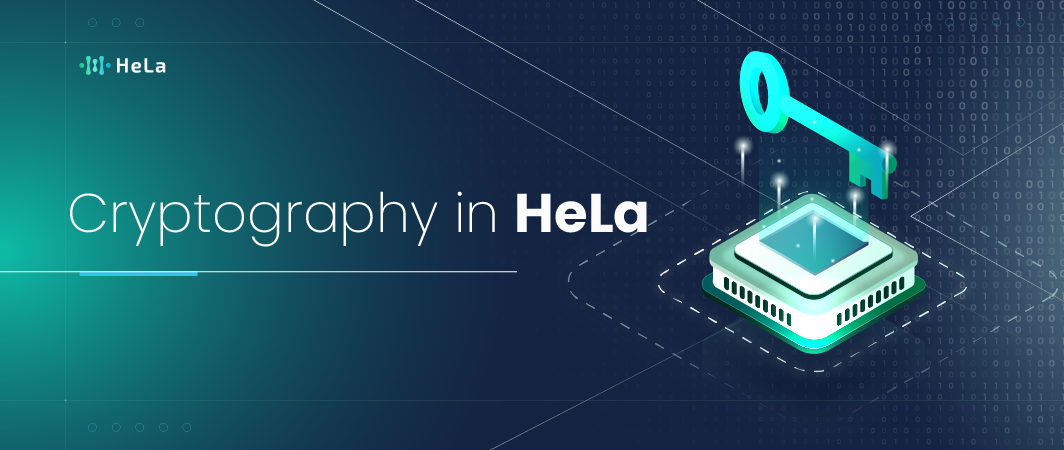Cryptography in HeLa
Sensitive information needs to remain confidential and protected from unauthorized access. Also, a fail-proof method of detecting illegal information modifications during information transmission and storage is crucial for blockchain adoption.
Additionally, blockchain users yearn for a precise method of verifying the identity of individuals, devices, or entities to prevent impersonation. Solving these problems should be immediate and worthwhile. This is where the HeLa blockchain comes in.
HeLa is a modular Layer-1 solution blockchain that fosters an open and inclusive ecosystem. We provide a level playing field for all builders to unleash their creativity and drive innovation.
As a next-generation Layer-1 blockchain protocol with a mission to bring Web3 into the real world, we use advanced cryptographic techniques, such as Hash algorithm SHA-512/256 for signing and canonical state at RootHash service, Ed25519 for signing message, encode message with CBOR.
We utilize Scalable Randomness attested by public entities in random beacons to verify the state between consensus and paratime chain. But what is the benefit of cryptography in Hela?
About HeLa’s Cryptography

HeLa’s cryptographic foundation is deeply embedded within its consensus and runtime layers, employing cutting-edge algorithms to ensure the blockchain protocol’s security, privacy, and efficiency.
We leverage the ed25519 cryptographic algorithm in the consensus layer, a state-of-the-art elliptic curve digital signature algorithm.
This choice reflects our commitment to robust security measures, providing a solid foundation for transaction validation and consensus within the network.
Meanwhile, in the runtime layer, particularly in its EVM compatibility, HeLa incorporates the ECDSA (specp256k1) algorithm. The Paratime Chain enables parallel timelines or “paratimes,” each with its cryptographic infrastructure, ensuring interoperability and security.
This compatibility ensures seamless integration and migration of applications within the ecosystem, offering users a familiar solution to expand their blockchain presence without the need to start from scratch.
Features of HeLa Cryptography

Enhancing Security and Canonical State with SHA-512/256 Algorithm
The SHA-512/256 hash algorithm for signing and maintaining canonical state offers an advanced cryptographic framework. By employing SHA-512/256, a truncated variant of SHA-512, we ensure both cryptographic robustness and operational efficiency.
This choice guarantees the derivation of fixed-length hash outputs, enhancing data integrity verification and transaction authentication processes. Furthermore, SHA-512/256’s resistance to collision attacks fortifies the security posture, mitigating potential threats to system integrity.
Through SHA-512/256 integration, our users benefit from heightened data security, fostering trust and reliability in system operations.
HeLa cryptography in consensus layer (ed25519): ED25519 for signing messages
The Edwards-Curve Digital Signature Algorithm (EdDSA) represents a cutting-edge cryptographic scheme rooted in elliptic curve cryptography (ECC) principles.
Unlike its predecessors, such as RSA and ECDSA, EdDSA boasts superior resilience against a wide array of side-channel attacks, including timing and power analysis attacks, thereby rendering it an optimal solution for deployment across diverse computational environments, particularly those characterized by resource constraints like embedded systems and mobile devices.
Central to EdDSA’s efficacy is its utilization of twisted Edwards curves, which facilitate efficient arithmetic operations and underpin its secure implementation.
Fundamentally, EdDSA relies on elliptic curve scalar multiplication and employs a one-time signature scheme dubbed the “hash-and-sign” approach.
This approach entails hashing the message to be signed and leveraging the resulting hash value as a secret key alongside the signer’s private key to generate the signature. The produced signature comprises two components: a point on the elliptic curve representing the R-value and a scalar representing the S-value.
With robust security assurances, streamlined computational efficiency, and resilience against diverse cryptographic attacks, HeLa Cryptography utilizes EdDSA as a preferred choice for digital signature applications within our cryptographic ecosystems.
Encode message CBOR
Concise Binary Object Representation (CBOR) is a binary data serialization format designed for efficient and compact encoding of data structures.
It offers developers a platform-independent solution for representing complex data in a concise binary format, optimizing storage and transmission overhead.
CBOR achieves this by employing a self-describing format that includes tags and types, allowing for seamless interpretation and interoperability across different platforms and programming languages.
You can leverage CBOR’s features to efficiently encode structured data, such as arrays, maps, strings, integers, and floating-point numbers, into a binary representation.
This compact representation minimizes the size of transmitted or stored data, reducing bandwidth usage and storage requirements.
Additionally, CBOR supports more advanced data types, including nested structures, indefinite-length items, and shared references, enabling developers to encode even complex data structures with ease.
Scalable randomness attested by public entities
One of the prominent features within HeLa’s cryptography suite is the random beacon service, designed to provide unbiased randomness during each epoch.
This feature implements a commit-reveal scheme backed by Provably Secure Secret Sharing (PVSS) protocols, ensuring the generation of secure entropy as long as the threshold of participants is met and at least one participant remains honest.
Node descriptors within HeLa maintain long-term elliptic curve points and scalar pairs, with public keys stored by the registry service.
The beacon generation process unfolds in three sequential stages: Commit, Reveal, and Complete (Transition Wait) Phase. Participants are selected during the Commit Phase to contribute encrypted shares, with malicious behaviors such as failing to submit a commitment or attempting to alter an existing one, resulting in exclusion.
The subsequent Reveal Phase sees participants revealing decrypted values of received shares, with similar malicious behaviors subject to exclusion. Upon successful completion, the final entropy output is recovered, signaling the end of the round. HeLa’s consensus supporting PVSS Commit and PVSS Reveal enhances the security and reliability of the entire cryptographic ecosystem.
HeLa Cryptography in the Para time chain/ HeLa Run time

HeLa’s cryptographic suite features the Paratime Chain and HeLa Runtime, both powered by the efficient and secure ECDSA (specp256k1) algorithm.
The Paratime Chain enables parallel timelines or “paratimes,” each with its cryptographic infrastructure, ensuring interoperability and security. ECDSA (specp256k1) secures transactions and validates blocks across the Paratime Chain network.
This integration offers developers a flexible platform for building decentralized applications and smart contracts, leveraging ECDSA’s security within HeLa’s runtime environments for reliable and scalable decentralized solutions.
HeLa: Transforming Real-World Adoption with Web3 Innovation
HeLa, a modular Layer-1 solution meticulously crafted by esteemed engineers and scientists in collaboration with A*STAR IHPC, is not just a blockchain protocol – it’s a visionary leap into the era of Web3.
With an emphasis on real-world adoption, HeLa transcends traditional blockchain boundaries, promoting inclusivity, creativity, and innovation for builders of all levels.
HeLa is not just a blockchain; it’s a catalyst for Web3 adoption. We combine cutting-edge features, an open ecosystem, and a visionary mission to propel the blockchain space toward a more inclusive, user-centric, and decentralized future.

Joshua Soriano
I am a writer specializing in decentralized systems, digital assets, and Web3 innovation. I develop research-driven explainers, case studies, and thought leadership that connect blockchain infrastructure, smart contract design, and tokenization models to real-world outcomes.
My work focuses on translating complex technical concepts into clear, actionable narratives for builders, businesses, and investors, highlighting transparency, security, and operational efficiency. Each piece blends primary-source research, protocol documentation, and practitioner insights to surface what matters for adoption and risk reduction, helping teams make informed decisions with precise, accessible content.
- Joshua Soriano#molongui-disabled-link
- Joshua Soriano#molongui-disabled-link
- Joshua Soriano#molongui-disabled-link
- Joshua Soriano#molongui-disabled-link

